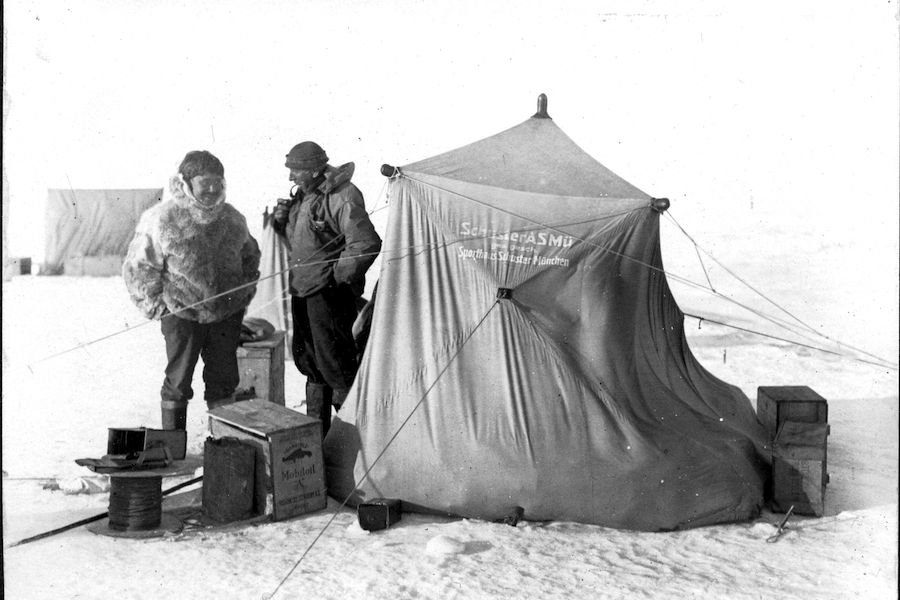Alfred Wegener: How the AWI got its name
50 years was the age Alfred Wegener reached when he died on his third expedition to Greenland. The Alfred Wegener Institute (AWI) is named after the noted German polar researcher and geophysicist.
Wegener, who was born on November 1, 1880, became well-known around the world owing to his theory that the continents and oceans developed due to continental drift. While his theory is fundamental to today’s understanding of plate tectonics it was largely rejected by other scientists during his lifetime. Although he first publicized his theory in 1912 that there was originally just one large continent, it was long after his death that other experts started to concur.
The first and second Greenland expeditions

Six years before that, Wegener, who had studied Physics, Meteorology and Astronomy, had already embarked on his first expedition to Greenland, which lasted from 1906 to 1908. There, under the Danish expedition leader Ludvig Mylius-Erichsen, he conducted meteorological studies using kites and tethered balloons up to a height of 3000 metres to collect new data on the Arctic climate and weather trends. The research results had a strong influence on his work in the following years. It was on this voyage that he met Johann Peter Koch, a glaciologist, who led the second expedition to the Arctic, in 1912, in which Wegener participated. Together with two others they were the first explorers to spend the winter on the inland ice in that part of the Arctic, before crossing Greenland from east to west. Wegener’s second expedition was also dedicated to scientific research. He collected a great deal of data on the glaciers and climate of northeast Greenland. These observations and measurements were later included in numerous works which Wegener published in the course of his life.
Wegener’s scientific work
Alfred Wegener’s major work “Die Entstehung der Kontinente und Ozeane” (“The Origin of Continents and Oceans”) was published in 1915. In it, he described how great forces pulled the continents apart over the course of the earth’s history, creating the continents that we know today. Up to that time, a majority of scientists assumed that the continents were immobile. Wegener was already theorizing then that the original single landmass was subject to various physical forces which caused it to drift apart. Despite the plausible explanations, his theory of continental drift was largely dismissed.
Final journey to the eternal ice
Wegener, however, was not put off by the scepticism about his theories, and continued to try to extend his knowledge. In 1930 he set out on his final expedition to Greenland. The aim was to gather continuous geophysical and meteorological data on the entire inland ice of Greenland with the help of measuring stations. To do this, he and his 20-strong team erected three permanent stations, one on either coast and one in the “Eismitte” (the middle of the inland ice).
However, the expedition suffered from numerous problems. The journey was delayed by the thickness of the ice; there was insufficient funding; and the propeller-driven snowmobiles were unable to deal with the fresh snow. In the end, Wegener decided to get to the “Eismitte” on his own with just two colleagues, Fritz Loewe and Rasmus Villumsen, in order to stock the station there with provisions. It was on Wegener's 50th birthday when he set off with Villumsen on the return journey to the station on the west coast – but neither of them made it. It was not until the following May that a search expedition found Wegener’s grave, which Villumsen had carefully marked. He is thought to have died around 16 November 1930. Villumsen was never found.
The Alfred Wegener Institute in Bremerhaven
Wegener’s unquenchable thirst for knowledge drove him to undertake several research voyages despite the very difficult conditions and to collect as much data as possible on the climate and weather in the Arctic. The scientists of the institute which is named after him pursue the same aim. The Alfred Wegener Institute, Helmholtz Centre for Polar and Marine Research was founded in 1980 and works in the coldest regions on Earth – the Arctic and the Antarctic – studying their role in the global climate system. The AWI is part of the Helmholtz Association of German Research Centres – Germany’s largest science organization, which pursues long-term research goals of society and the state.

The AWI employs more than 1000 staff at its headquarters in Bremerhaven in northern Germany and three offices in Potsdam, Sylt and Heligoland. In addition to carrying out research in the polar regions, the AWI’s scientists also work in the German coastal regions and the North Sea, to study the atmosphere, the climate and their worldwide impacts. Because polar and marine research also poses major logistical challenge, the AWI has excellent infrastructure, which it also makes available to both the German and international science communities. This includes several research vessels and aircraft, as well as research stations in the Arctic and Antarctic.
For the purpose of intensifying its research, the AWI participates in many international expeditions, among them the project “Multidisciplinary drifting Observatory for the Study of Arctic Climate“ (MOSAiC) which begins in the autumn of 2019. This will involve the research icebreaker POLARSTERN becoming deliberately trapped in the ice, so that it can drift across the polar cap. One of the aims of this expedition involving scientists from 17 different countries is to collect valuable data about the Arctic winter.